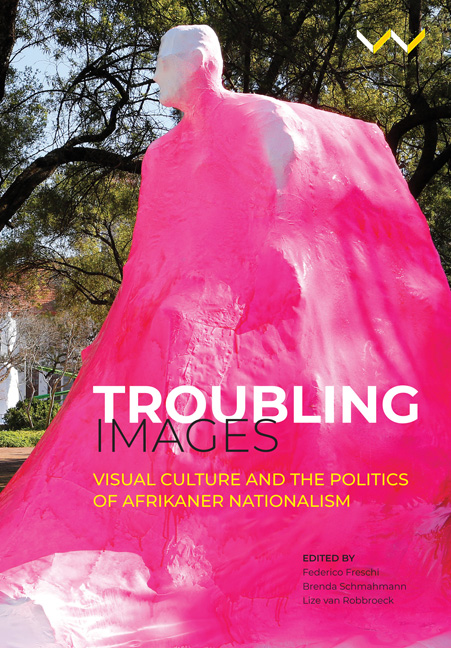Book contents
- Frontmatter
- Contents
- Acknowledgements
- List of Illustrations
- Troubling Images: An Introduction
- 1 The Trajectory and Dynamics of Afrikaner Nationalism in the Twentieth Century: An Overview
- One Assent and Dissent Through Fine Art and Architecture
- Two Sculptures on University Campuses
- Three Photography, Identity and Nationhood
- Four Deploying Mass Media and Popular Visual Culture
- Contributor Biographies
- Index
2 - Afrikaner Nationalism and Other Settler Imaginaries at the 1936 Empire Exhibition
Published online by Cambridge University Press: 21 March 2020
- Frontmatter
- Contents
- Acknowledgements
- List of Illustrations
- Troubling Images: An Introduction
- 1 The Trajectory and Dynamics of Afrikaner Nationalism in the Twentieth Century: An Overview
- One Assent and Dissent Through Fine Art and Architecture
- Two Sculptures on University Campuses
- Three Photography, Identity and Nationhood
- Four Deploying Mass Media and Popular Visual Culture
- Contributor Biographies
- Index
Summary
The 1930s was a time of intensive settler nation-building in the British Dominions. The Balfour Declaration of 1926 and the Statute of Westminster in 1931 proclaimed the independence of the Dominions and their parity with Britain, heralding the first steps in institutionalising the British Commonwealth of Nations. The interwar years were, as Christine Boyanoski (2002, 12) suggests, a ‘crucial moment in the history of cultural relations between Great Britain and the former white colonies of settlement; for while the latter gained political independence through the process of decolonisation during these years, cultural independence was less easily attained’. New nationhood demanded signs of a national character that could be displayed in both high and popular cultural spaces, not only to invent a national settler imaginary, but also to boost tourism and commerce between domains. The challenge was to generate an iconography that would produce distinct white national identities that accorded with the goals of empire, while simultaneously pacifying and/or suppressing potentially resurgent anti-imperial nationalisms.
In South Africa, the early twentieth-century construction of a national identity presented unique challenges. Barely three decades before, the South African (Anglo-Boer) War had left the empire significantly weakened, while the defeated Boers resented the loss of their hard-won independence. Under these circumstances, the attempt to manufacture unity among South Africa's divided settler polity rendered the conciliatory Fusion politics of the 1930s tenuous, no matter how robustly it was promoted through events such as the Empire Exhibition.
Afrikaner affiliations were split between, on the one hand, politicians (such as Jan Smuts) who advocated unification under the British Commonwealth and, on the other, ideologues as well as numerous political and cultural organisations passionately promoting republican ideals. By and large, the white English-speaking population was resented for what many Afrikaners regarded as blind allegiance to the Crown, while the English-speaking capitalist elite provoked strong class antagonisms (Bozzoli 1976). In the shadows of this blinding whiteness, increasingly marginalised African nationalist groupings tried to forge a unified African imaginary to counter the relentless erosion of native rights and the exclusionary politics of Union.
The nascent white national imaginaries mobilised visual culture to claim distinctiveness, yet ironically tended to share visual strategies and vocabularies, revealing nationalism as a shared signifying system across ideological and ethnic schisms
- Type
- Chapter
- Information
- Troubling ImagesVisual Culture and the Politics of Afrikaner Nationalism, pp. 43 - 65Publisher: Wits University PressPrint publication year: 2020

